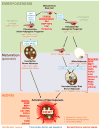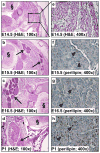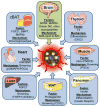Brown adipose tissue: development, metabolism and beyond
- PMID: 23805974
- PMCID: PMC3887508
- DOI: 10.1042/BJ20130457
Brown adipose tissue: development, metabolism and beyond
Abstract
Obesity represents a major risk factor for the development of several of our most common medical conditions, including Type 2 diabetes, dyslipidaemia, non-alcoholic fatty liver, cardiovascular disease and even some cancers. Although increased fat mass is the main feature of obesity, not all fat depots are created equal. Adipocytes found in white adipose tissue contain a single large lipid droplet and play well-known roles in energy storage. By contrast, brown adipose tissue is specialized for thermogenic energy expenditure. Owing to its significant capacity to dissipate energy and regulate triacylglycerol (triglyceride) and glucose metabolism, and its demonstrated presence in adult humans, brown fat could be a potential target for the treatment of obesity and metabolic syndrome. Undoubtedly, fundamental knowledge about the formation of brown fat and regulation of its activity is imperatively needed to make such therapeutics possible. In the present review, we integrate the recent advancements on the regulation of brown fat formation and activity by developmental and hormonal signals in relation to its metabolic function.
Figures



References
-
- Gesta S, Tseng YH, Kahn CR. Developmental origin of fat: tracking obesity to its source. Cell. 2007;131:242–256. - PubMed
-
- Bartelt A, Heeren J. The holy grail of metabolic disease: brown adipose tissue. Curr Opin Lipidol. 2012;23:190–195. - PubMed
-
- Jackson AS, Stanforth PR, Gagnon J, Rankinen T, Leon AS, Rao DC, Skinner JS, Bouchard C, Wilmore JH. The effect of sex, age and race on estimating percentage body fat from body mass index: The Heritage Family Study. Int J Obes Relat Metab Disord. 2002;26:789–796. - PubMed
Publication types
MeSH terms
Grants and funding
LinkOut - more resources
Full Text Sources
Other Literature Sources
Molecular Biology Databases

